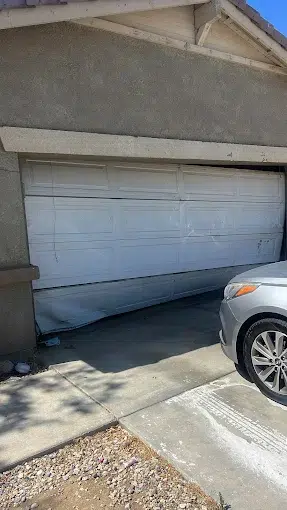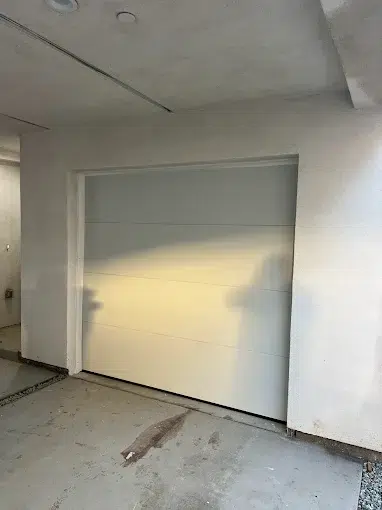Dealing with a troublesome overhead entryway can be a real headache. It’s one of those things you don’t think about until it stops working. Suddenly, your daily routine is disrupted. But don’t worry, many common issues can be addressed with a little know-how. Understanding the problem is the first step. This guide will walk you through some frequent signs of a broken garage door and what you can do about them.
Common Signs of a Broken Garage Door
Is your entryway making strange noises, like grinding or squeaking? Or maybe it’s moving unevenly or getting stuck. These are clear indicators that something is wrong.
An entryway that won’t open or close at all is the most obvious sign of a problem. Sometimes, the issue is as simple as dead batteries in the remote.
Other times, it could point to a more significant issue with the opener or the springs. Paying attention to these early warnings can help you prevent a complete breakdown. Catching a problem early often means a simpler and less costly fix.
If you suspect an issue with your entryway, it is important to address it. A malfunctioning entryway can be a safety hazard. Don’t ignore the signs of a broken garage door.
Taking a few moments to investigate can save you a lot of trouble down the road. If the problem seems complex, it is always best to call a professional for assistance.

How to Fix a Broken Garage Door Spring
One of the most common reasons for a broken garage door is a faulty spring. These springs are under a lot of tension to lift the heavy panel. If you hear a loud bang from your entryway area, a spring has likely snapped. You might also notice that the opener strains to lift the entryway, or it won’t open at all. Replacing a spring can be a dangerous task if you’re not careful.
Safety Precautions When Dealing with a Broken Spring
Before you attempt any work on your broken garage door spring, make sure the entryway is disconnected from the opener. This will prevent it from moving unexpectedly. You’ll also want to secure the panel in place. Never try to adjust or remove the springs without the proper tools. Winding bars are essential for this job. Also, always wear safety glasses and gloves. It’s a good idea to have a friend help you. This is not a one-person job due to the weight and tension involved.
Troubleshooting a Garage Door Opener
Sometimes, the issue isn’t with the entryway itself but with the opener. If the broken garage door opener is running, but the entryway isn’t moving, there might be a disconnect. Check to see if the emergency release cord has been pulled. Also, inspect the safety sensors at the bottom of the tracks. They need to be aligned and free of obstructions. If they are not, the entryway won’t close properly.
How to Open a Garage Door When the Opener Fails
If your opener is on the fritz, you can still open the entryway manually. First, pull the red emergency release cord. This will disconnect the entryway from the opener’s trolley. Then, you should be able to lift the panel by hand. Be careful, as it will be heavy without the spring’s assistance. It is best to have someone help you lift it to avoid injury. A broken garage door can be a serious safety risk.

Preventive Maintenance to Avoid Future Garage Door Issues
Regular maintenance can help you avoid many common problems. Keeping the moving parts lubricated is a great start. This reduces friction and wear. You should also regularly check the hardware and tighten any loose bolts. Testing the balance of the entryway is another important step. A well-maintained entryway is less likely to become a broken garage door.
Here are a few simple maintenance tips:
- Inspect and clean the tracks regularly.
- Test the auto-reverse safety feature monthly.
- Check the cables for any signs of fraying or wear.
- Replace the weatherstripping if it becomes brittle or cracked.
By following these simple steps, you can keep your entryway running smoothly. A little bit of prevention goes a long way. And remember, if you ever feel a task is beyond your skill level, it’s always safest to call in a professional to handle your broken garage door.
FAQ
My garage door won't open and close, what do I do?
If your garage door won’t open or close, first check the power and remote batteries. Ensure the safety sensors are aligned and unobstructed. You can also try pulling the emergency release cord to operate it manually. If these steps don’t work, you may need professional garage door repair.
How do I replace a garage door spring that is broken?
Replacing a broken torsion spring is dangerous due to the extreme tension. It involves unwinding the old one and installing a new one, which requires special tools. A mistake can cause serious injury. This garage door torsion spring replacement is best left to a professional for safe and correct installation.
How do I repair a garage door with a broken spring?
Repairing a garage door with a broken spring involves replacement. A professional technician will secure the door, release the tension from the old system, and install a new one matched to the weight of the door to properly lift the door. For safety, always call for professionals
